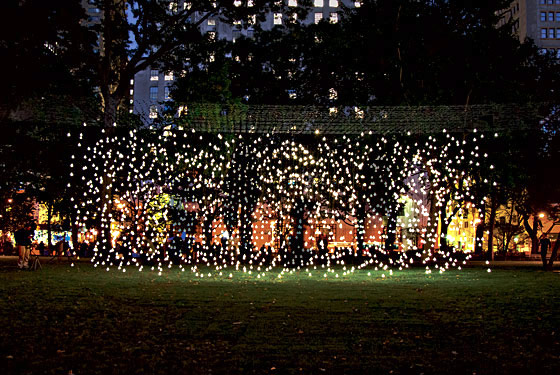
A first glance, the hundreds of dangling lightbulbs that make up Jim Campbell’s monumental, three-dimensional Madison Square Park installation Scattered Light seem to flicker at random. Look closer, though, and you’ll soon make out shadowy humanoid figures moving briskly across the “pixels” represented by those suspended lights. “It’s about exploding an image, tearing it apart, and spreading it out,” says Campbell, whose latest piece seeks to play tricks with our usual depth perception— expanding a 2-D scene into three real dimensions—all the while creating a contrast between urban bustle and the cool darkness of the nighttime park. We asked him to walk us through.
1. PICK A SPOT
Campbell began by hanging around Madison Square, watching the pedestrian flow. “People are slower-paced in the park. Versus, you know, a block away—where they’re completely not.” He also noticed that people lingered for a surprisingly long time. “I figured people would actually spend time with the installation here. In Columbus Circle, you might see it as you zip by.”
2. GRAB SOURCE MATERIAL
Campbell also camped out in Grand Central Terminal, where he recorded video of commuters dashing around the concourse. “People are moving in all kinds of directions there—not just perpendicular or parallel to you. It has a slightly chaotic, explosive feel.” Nighttime visitors will in effect be peering into an earlier, speedier part of their own day. “I think that’s more thought-provoking: seeing yourself somewhere else as opposed to seeing yourself then.”
3. TURN IT INTO CODE
Campbell, trained at M.I.T. as an electrical engineer, pared down the video file into a set of very high-contrast images, and downloaded that information to custom-built circuitry (feeding five miles of wire) that switches lights on and off. The programming had to be “very precisely” tuned to the distance between lightbulbs, to give the movements realistic shape and speed.
4. CREATE DEPTH
Two thousand lights dangle on the sculpture’s framework. It’s not evident at first to the viewer who comes at the work broadside, as in the photo above, but the strands are layered, some closer in, some farther away. That allows the figures to move through three dimensions. “If you saw the work from extremely far away, you wouldn’t be able to tell it was 3-D,” says Campbell. “It would flatten out and just look like a curtain of lights.” As you walk around it on the curving path through the park, the shadow play gradually becomes abstract twinkling.
5. CONSIDER THE PLANET
“An old-fashioned lightbulb is the symbol of inefficiency,” says Campbell. “I didn’t want to do a sculpture that had 2,000 symbols of inefficiency as the medium.” But he did want to preserve the classic teardrop shape, so he and his assistants took thousands of standard lightbulbs, sawed them open, stuffed them with LEDs, and glued them back together, making handmade, unique, energy-efficient hybrids. (Amazingly, only a few broke.) “I’m waiting for the review that calls the work extremely inefficient.”
6. THE RESULT
The bulbs are warm and white, and for the most part, the figures appear dark among them. But not always. “Every once in a while, somebody’ll walk by in a white shirt, and then it’s brighter than the background,” says Campbell. For the most part, though, his subjects were dressed in dark suits. “It’s just what it was. It’s New York: Most people are wearing black.”